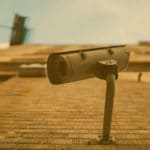Tenth Amendment Center: Vermont Bill Would Would Establish Oversight, Help End Unchecked Police Surveillance

MONTPELIER – Vt. (March 27, 2019) – A bill introduced in the Vermont House would require Vermont law enforcement agencies to obtain legislative approval before acquiring or using surveillance technology. Passage of the bill would take the first step toward limiting the unchecked use of surveillance technologies that violate basic privacy rights and feed into a broader national surveillance state.
Rep. Narnara Rachelson (D-Burlington) introduced House Bill 470 (H.470) on Feb. 27. The legislation would require Vermont law enforcement agencies to get legislative approval before acquiring or using surveillance technology including facial or tattoo recognition software, genetic DNA testing, stationary license plate readers, cell site simulators, and international mobile subscriber identity-catchers. Law enforcement agencies would also have to get legislative approval before purchasing, trading, or obtaining information from private or public entities gained from the use of such technology.
Access
Local police have access to a mind-boggling array of surveillance equipment. As it now stands, many law enforcement agencies can obtain this high-tech, extremely intrusive technology without any approval or oversight. The federal government often provides grants and other funding sources for this spy-gear, meaning local governments can keep their purchase “off the books.” Members of the community, and even elected officials, often don’t know their police departments possess technology capable of sweeping up electronic data, phone calls and location information.
In some cases, the feds even require law enforcement agencies to sign non-disclosure agreements, wrapping surveillance programs in an even darker shroud of secrecy. We know for a fact the FBI required the Baltimore Police Department to sign such an agreement when it obtained stingray technology. This policy of nondisclosure even extends to the courtroom, with the feds actually instructing prosecutors to withdraw evidence if judges or legislators press for information. As the Baltimore Sun reported, a Baltimore detective refused to answer questions about the department’s use of stingray devices on the stand during a trial, citing a federal nondisclosure agreement.
As privacysos.org put it, “The FBI would rather police officers and prosecutors let ‘criminals’ go than face a possible scenario where a defendant brings a Fourth Amendment challenge to warrantless stingray spying.”
H.470 would prevent state and local police in Vermont from obtaining technology without public knowledge and would provide an avenue for concerned residents to oppose and stop the use of some spy gear.
Impact on Federal Programs
Information collected by local law enforcement undoubtedly ends up in federal databases. The feds can share and tap into vast amounts of information gathered at the state and local level through fusion centers and a system known as the “information sharing environment” or ISE. In other words, stingrays create the potential for the federal government to track the movement of millions of Americans with no warrant, no probable cause, and without the people even knowing it.
Fusion centers were sold as a tool to combat terrorism, but that is not how they are being used. The ACLU pointed to a bipartisan congressional report to demonstrate the true nature of government fusion centers: “They haven’t contributed anything meaningful to counterterrorism efforts. Instead, they have largely served as police surveillance and information sharing nodes for law enforcement efforts targeting the frequent subjects of police attention: Black and brown people, immigrants, dissidents, and the poor.”
Fusion centers operate within the broader ISE. According to its website, the ISE “provides analysts, operators, and investigators with information needed to enhance national security. These analysts, operators, and investigators…have mission needs to collaborate and share information with each other and with private sector partners and our foreign allies.” In other words, ISE serves as a conduit for the sharing of information gathered without a warrant. Known ISE partners include the Office of Director of National Intelligence which oversees 17 federal agencies and organizations, including the NSA. ISE utilizes these partnerships to collect and share data on the millions of unwitting people they track.
The federal government encourages and funds surveillance technology including ALPRs, drones and stingrays at the state and local level across the U.S. In return, it undoubtedly gains access to a massive data pool on Americans without having to expend the resources to collect the information itself. By requiring approval and placing the acquisition of spy gear in the public spotlight, local governments can take the first step toward limiting the surveillance state at both the local and national level.
In a nutshell, without state and local cooperation, the feds have a much more difficult time gathering information. This represents a major blow to the surveillance state and a win for privacy.
The passage of H.470 would take an important first step toward limiting the use of surveillance technology by addressing it at the local level.
WHAT’S NEXT
H.470 was referred to the House Committee on Judiciary where it must pass by a majority vote before moving forward in the legislative process.
Mike Maharrey
March 28, 2019 at 04:09PM
